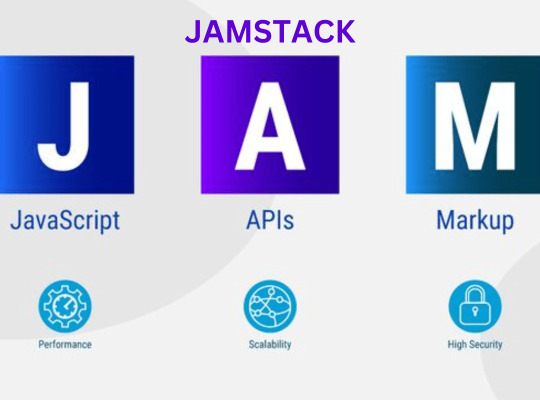#WORDPRESS EXPLOIT FRAMEWORK
Explore tagged Tumblr posts
Text
The Rise of Jamstack and How It’s Changing Web Development
Web development is evolving fast—and one of the most game-changing shifts in recent years has been the rise of Jamstack. What started as a modern architecture for static websites has grown into a movement that’s transforming how developers build, deploy, and scale digital experiences.
Forward-thinking businesses are now turning to Jamstack for its speed, scalability, and security. And the smartest Web Development Company teams are adopting this approach to future-proof client projects and deliver better performance across the board.
So what exactly is Jamstack? And why is it taking the development world by storm?
What Is Jamstack?
Jamstack is a web development architecture based on three core components:
JavaScript (handles dynamic functionalities)
APIs (connects to services or databases)
Markup (pre-rendered static HTML)
Unlike traditional monolithic setups (like WordPress or PHP-based platforms), Jamstack sites decouple the front-end from the back-end. This means content is often served as static files via CDNs, while dynamic features are handled through APIs or serverless functions.
Popular Jamstack tools and frameworks include:
Next.js, Gatsby, and Nuxt.js
Netlify and Vercel for deployment
Contentful, Sanity, or Strapi as headless CMS options
Why Is Jamstack Gaining Popularity?
1. Speed Like Never Before
Jamstack sites are blazingly fast because most of the content is pre-rendered and distributed via a CDN. Users don’t have to wait for server-side processing—everything loads instantly.
This makes a massive difference for:
Page load times
Core Web Vitals scores
Bounce rates and conversions
2. Enhanced Security
Since Jamstack sites don’t rely on traditional server-side logic or databases during runtime, the attack surface is significantly reduced. There’s no server to hack, no plugin to exploit, and no direct database exposure.
This makes it ideal for projects that need:
High security standards
Less maintenance
GDPR or HIPAA-compliant structures
3. Scalability on Demand
Jamstack apps scale effortlessly because they serve static assets through globally distributed CDNs. Even during traffic spikes, there’s no performance bottleneck.
For eCommerce stores, product launches, and viral campaigns, this reliability is a major advantage.
4. Developer Flexibility and Workflow Improvements
Jamstack supports a modern developer experience, including:
Git-based workflows
Atomic deployments (rollback-friendly)
CI/CD pipelines
API-driven integrations
This speeds up collaboration, reduces deployment risk, and improves productivity across teams.
5. Seamless Headless CMS Integration
In Jamstack, content is usually managed via a headless CMS. These platforms allow content teams to edit without touching code, while developers fetch that content via API and build rich front-end experiences.
This separation of concerns allows:
Non-technical users to manage updates
Developers to focus purely on performance and design
Faster iteration across all content layers
Real-World Use Cases of Jamstack
Jamstack isn’t just theoretical. It’s being used across industries:
Startups use it for MVPs and marketing websites that need to launch fast.
eCommerce brands build storefronts with frameworks like Next.js + Shopify API.
Agencies and freelancers create client sites that are secure, low-maintenance, and high-performance.
SaaS platforms leverage Jamstack for landing pages and docs that integrate seamlessly with user dashboards.
How It’s Changing Web Development
Jamstack is redefining what “modern development” means:
From backend-heavy to API-driven: Teams can now plug in services (auth, payments, search) without building from scratch.
From slow deploys to continuous deployment: With Git hooks and serverless functions, updates go live in minutes.
From monoliths to micro-frontend architecture: Developers can build apps as modular blocks, making scaling and testing easier.
These shifts are pushing developers—and their clients—towards a future where performance, modularity, and user experience are prioritized from the start.
Conclusion
Jamstack is not just a trend—it’s a fundamental shift in how websites and apps are built. By embracing static-first, API-driven architecture, it empowers brands to deliver faster, safer, and more scalable digital experiences.
A forward-looking Web Development Company will know how to leverage Jamstack for your specific needs—whether you're launching a fast-loading landing page, a content-rich blog, or a dynamic eCommerce platform.
As the web continues to evolve, Jamstack offers a leaner, smarter way to build—and stay ahead of the curve.
0 notes
Text
Internal Coherence Maximization (ICM): A Label-Free, Unsupervised Training Framework for LLMs
Post-training methods for pre-trained language models (LMs) depend on human supervision through demonstrations or preference feedback to specify desired behaviors. However, this approach faces critical limitations as tasks and model behaviors become very complex. Human supervision is unreliable in these scenarios as LMs learn to mimic mistakes in demonstrations or exploit inherent flaws in…

View On WordPress
0 notes
Text
Against Marx - The Austrian Economists - Menger
Marx’s Theory of Value Refuted. Karl Marx posited that the value of a commodity is derived from the labor expended in its production, anchoring value in the objective measure of labor time. This labor theory of value underpinned Marx’s economic framework, tying value to the collective effort of workers and framing economic systems as driven by class dynamics and exploitation. Marx’s perspective…

View On WordPress
0 notes
Text
Identity Attack Surface Management (IASM): The Convergence of Identity Security Frameworks
Identity security has undergone a transformative shift in recent years. While traditional solutions like Identity and Access Management (IAM), Identity Governance and Administration (IGA), and Privileged Access Management (PAM) remain foundational, they were not designed to address the dynamic, identity-centric threats of modern cyberattacks. Attackers increasingly exploit identity…

View On WordPress
#assistant professor#computer science#computer scientist#engineering#experimental roboticist#research scientist#university of denver
0 notes
Text
How to Prevent Web Cache Deception Attacks in Laravel: A Complete Guide
Introduction to Web Cache Deception Attack Web Cache Deception (WCD) is a vulnerability that occurs when sensitive data is improperly cached by web servers or reverse proxies, which leads to the exposure of private information. This attack typically exploits a misconfigured caching mechanism, causing private user data to be stored in a public cache. Laravel, being a popular PHP framework, is not…

View On WordPress
0 notes
Text
There’s an entire category for Wordpress exploits in several hacking frameworks, CVE disclosure databases, and other hacking tools. This is a bad idea.
automattic's made a ton of blunders recently but i hope they're not gonna try something like convert tumblr to run on wordpress, a project that both tumblr and wordpress engineers agreed would be a lot of work for no gain (most likely worse performance). that would be a silly thing to do.
12K notes
·
View notes
Text
The Ultimate Guide to Jamstack: Faster, Secure, and SEO-Friendly Web Development
Web development is moving towards the faster, secure, and scalable solutions, with Jamstack as the leader. This new architecture is replacing old server-heavy approaches by using pre-built static pages, APIs, and dynamic JavaScript to create fast websites. When businesses demand a better user experience, improved SEO, and a cost-effective solution, Jamstack is the preference for developers and marketers alike.

What is Jamstack?
Jamstack is essentially a decoupled web architecture that separates front-end from server logic and also database. Such architecture relies mainly on three significant elements:
JavaScript – It enhances interactivity on the client end and dynamic functions.
APIs – Handles server-side operations, such as authentication, payments, and updating of content.
Markup – Pre-rendered HTML files that are served directly from a Content Delivery Network (CDN) for ultra-fast performance.
Unlike the traditional, monolithic, server-based, dynamically generating web applications on request, Jamstack builds the page and serves it immediately to a user. Thus, the load times become quicker, dependency on servers decreases, and security also gets strengthened.
Why is Jamstack gaining popularity?
Jamstack is gaining adoption across all industries because it is efficient, flexible, and capable of delivering the demands of modern web requirements. Here is why businesses and developers are shifting to this:
1. Blazing-Fast Performance
Speed is the primary factor that user experience and SEO look into. Since Jamstack serves pre-built static files through CDNs, websites are loading almost instantaneously, hence fewer bounces, and users can engage longer with the site. Also, the TTFB is kept minimal because it gets content from the nearest edge server, and during traffic spikes, it runs really smooth.
2. Enhanced Security.
The traditional CMS platforms (like WordPress) are full of database vulnerabilities, plugin risks, and server-side security flaws. Jamstack is free from these issues since it serves static files without a direct database. Because dynamic functions are handled through APIs, the attack surface drastically decreases, thereby making it tough for hackers to exploit weaknesses.
3. Effortless Scalability
Jamstack websites scale seamlessly without requiring complex backend infrastructure. Unlike traditional designs that require upgrading servers to accommodate surges in traffic, Jamstack CDN architecture designs spread content really smoothly: performance will be flawless both when there are 100 and when there are 1 million visitors.
4. Lower Operational Costs
These traditional websites require more server resources, database management, and updates that become quite costly. The Jamstack sites are static, light, and need minimal server usage, minimizing the hosting costs. This way, businesses can even allow third-party APIs to integrate features for dynamic functionalities such as authentication or forms without having to maintain a full-stack backend.
5. SEO Optimization
Google gives preference to web pages with better loading times, mobile responsiveness in search results. Jamstack sites improve core web vitals including:
Page Speed – Quicker load time = better rank.
Interactivity– Faster Response Times = improved User Experience.
Visual Stability – the HTML of your page pre-renders giving a more pleasant user experience to browse your webpage.
Adopting Jamstack will lead your business towards high SEO ranking and organic traffic conversion rates.
6. Decoupled Frontend & Backend
The modular approach of Jamstack separates the frontend from the backend services. Developers can thus:
Utilize modern frameworks like Next.js, Gatsby, or Nuxt.js.
Integrate headless CMSs like Contentful, Strapi, or Sanity.
Deploy updates without depending on backend dependencies.
This flexibility allows businesses to adapt and innovate faster, not being stuck in a rigid system.
7. Simple Deployment & Hosting
Easy deployment is now provided by the Netlify, Vercel, and GitHub Pages platforms. Through CI/CD pipelines, the developers are allowed to easily push code updates into production environments without much interruption time. Further, built-in rollbacks give the teams a possibility to return instantly to previously published versions.
8. Collaborative & Version Controlled Work
Because Jamstack is built on top of Git, collaboration between many developers is straightforward and easy through tools like GitHub, GitLab, or Bitbucket. The following are benefits teams can reap with Jamstack:
Change tracking and version management
Work on different parts of a project at different times.
Error-free deployments using automated testing and CI/CD workflows.
It makes it very suitable for big development teams and remote collaboration.
Why Marketers Love Jamstack
Jamstack isn’t only developer friendly, it is a game changer for the digital marketers as well. Here is why,
SEO friendly: fast websites rank high on Google
Zero downtime: no downtimes
Creativity and Flexibility: Build custom landing pages using Headless CMS integration.
Instant launch campaigns: publish new pages or update live pages with no developers bottlenecks.
With higher engagement, better performance, and cost savings, Jamstack is the go-to solution for digital marketing teams.
Challenges of Implementing Jamstack
While Jamstack has many benefits, it also has some drawbacks:
Learning Curve – Developers who are used to traditional CMSs may take some time to get accustomed.
Complex Dynamic Features – Some real-time features, such as live chats, need extra API configurations.
API Dependency- As most of the logic happens at the backend through APIs, the handling of third-party services becomes increasingly complicated.
However, all the above-mentioned challenges can be mitigated using the right tool and expertise; therefore, making Jamstack an effective solution in modern web development.
Final Thoughts: The Future of Web Development is Jamstack
Jamstack is changing the game in web business with regards to speed, security, scalability, and flexibility. With its ability to maximize performance, search engine optimization, and cost, it has already set the benchmark as the golden standard for web applications. This applies to anyone-from a developer to a businessman-to a marketer interested in a great-performing website, because of SEO, which leads to higher conversion.
0 notes
Text
Loginizer WordPress Plugin Review: A Comprehensive Guide

In the dynamic landscape of the internet, where the digital realm intertwines with countless facets of our daily lives, the security of online platforms, particularly websites, has become an imperative concern. WordPress, which powers a significant portion of the internet, stands as a prime target for cyber threats. As the foundation of numerous websites, its vulnerabilities are often exploited by malicious actors seeking unauthorized access, data breaches, and other nefarious activities. Recognizing the gravity of these threats, web administrators are compelled to fortify their WordPress websites with robust security measures. Among these, the login system represents a critical juncture, susceptible to various forms of attacks such as brute force attempts, password breaches, and unauthorized logins. In response to this, the Loginizer WordPress Plugin Review emerges as a pivotal tool, designed to enhance the security of WordPress login systems comprehensively. This article embarks on a detailed exploration of the Loginizer plugin, dissecting its features, usability, and overall efficacy in bolstering WordPress login security. From understanding the broader security landscape to delving into the intricate details of the plugin's installation and performance impact, each section aims to provide a nuanced perspective on how Loginizer contributes to a more secure WordPress environment. Join us on this journey through the realms of WordPress security as we unravel the layers of Loginizer's capabilities and assess its role in fortifying the digital gateways of your online presence.
Understanding the Security Landscape
The WordPress biological system, directing more than 40% of the web, is a worthwhile objective for digital dangers. With its far and wide utilization comes a bunch of weaknesses, including obsolete plugins, frail passwords, and defenselessness to savage power assaults. These normal entanglements stress the direness of executing hearty safety efforts, especially in the login framework, which fills in as an entryway to the immense computerized spread of a WordPress site. The pervasiveness of these weaknesses highlights the significance of perceiving the security scene encompassing WordPress. A failure point in the login framework can open a site to unapproved access, information breaks, and different vindictive exercises. As web executives explore the mind boggling landscape of WordPress security, the requirement for an exhaustive arrangement like Loginizer becomes obvious. This segment means to dig further into the particular dangers looked by WordPress sites and how Loginizer tends to these difficulties head-on, giving a strong groundwork to a safer web-based presence. From the hazards of obsolete plugins to the versatility against savage power assaults, we'll explore through the security scene to comprehend the reason why Loginizer stands apart as a significant player in the protection against digital dangers.
Features of Loginizer
In the domain of WordPress security, the Loginizer plugin arises as a guide of protection, furnished with a vigorous arrangement of highlights pointed toward sustaining the weak section point — the login framework. We should take apart the key components that make Loginizer a key instrument for protecting your WordPress site. Beast Power Security Instruments: One of the champion highlights of Loginizer is its hearty safeguard against savage power assaults. By restricting the quantity of login endeavors, the plugin upsets noxious entertainers endeavoring to acquire unapproved access by over and again attempting different secret key mixes. Two-Component Verification Choices: Perceiving the significance of an extra layer of safety, Loginizer offers two-factor confirmation. This element adds an additional confirmation step past a conventional username and secret phrase, guaranteeing that regardless of whether login qualifications are compromised, unapproved access stays an impressive test. IP Hindering and Whitelisting Abilities: Loginizer engages chairmen with command over access in view of topographical areas through IP obstructing and whitelisting. This component upgrades security by confining or permitting login endeavors from explicit districts, giving chairmen granular command over who can get to the site. Ongoing Checking and Notices: Proactivity is key in security, and Loginizer succeeds in this viewpoint. Continuous observing of login endeavors, combined with moment warnings, permits executives to remain in front of possible dangers. Opportune alarms empower quick reactions to dubious exercises, forestalling security breaks before they happen. In contrast with other security plugins available, Loginizer's list of capabilities offers a comprehensive way to deal with login security. From countering animal power assaults to giving continuous experiences, the plugin means to cover each feature of likely weaknesses.
Installation and Setup
Implementing a robust security solution should not be a daunting task, and Loginizer ensures a user-friendly experience right from the installation phase. Let's delve into the step-by-step process of installing and setting up Loginizer, ensuring that users can navigate this critical aspect of WordPress security effortlessly. Step-by-Step Installation Guide: Installing Loginizer begins with a straightforward process. Users can access the WordPress dashboard, navigate to the 'Plugins' section, and select 'Add New.' Searching for "Loginizer" and clicking 'Install Now' initiates the installation process. Once installed, users can activate the plugin and proceed to the configuration phase. Configuration Options and Settings: Upon activation, Loginizer prompts users to configure essential settings through an intuitive setup wizard. This wizard guides users through key parameters, such as login attempt thresholds, IP whitelisting, and two-factor authentication setup. Administrators can tailor these settings to align with the specific security requirements of their website. Tips and Best Practices: To optimize the efficacy of Loginizer, users can benefit from additional tips and best practices offered during the installation and setup process. These insights provide valuable guidance on configuring the plugin for maximum security, ensuring that users harness its full potential. By demystifying the installation and setup process, Loginizer aims to make security accessible to users of varying technical proficiency. The customization options provided during setup empower administrators to tailor the plugin to the unique security needs of their WordPress site.
User Experience
A security arrangement's viability is intently attached to the client experience, and Loginizer focuses on a consistent and instinctive point of interaction to take special care of a different client base. This segment investigates the different features of the client experience inside the Loginizer plugin, from its easy-to-understand plan to the joining of visual guides. Natural UI: Loginizer separates itself with an instinctive UI that takes care of both fledgling and experienced clients. The dashboard is intended for clarity, introducing fundamental security data in a fathomable way. Exploring through elements, settings, and security logs is smoothed out, guaranteeing that clients can get to and grasp the plugin's functionalities without pointless intricacy. Screen captures and walkthroughs: To upgrade client understanding, Loginizer is joined by visual guides, for example, screen captures and walkthroughs. These visual components furnish clients with a down-to-earth showing of the plugin's highlights, working with a smoother onboarding process and limiting the expectation to learn and adapt related to security designs. Client Tributes: Client tributes further underline Loginizer's obligation to the client experience. Input from clients features the plugin's harmony among refinement and availability, adulating its plan components and convenience. Genuine encounters shared by clients act as a demonstration of the plugin's viability and easy-to-use nature. By zeroing in on the client experience, Loginizer means to enable clients of all expertise levels to assume responsibility for their site security. The joining of visual guides, combined with a natural connection point, adds to a positive client experience, cultivating trust in using the plugin's strong security highlights.
Performance and Resource Impact
Concerns about the performance impact of security plugins are common among website administrators. In this section, we delve into how Loginizer strikes a delicate balance between providing robust security measures and maintaining optimal website performance. Resource Usage Metrics: One notable aspect of Loginizer is its efficiency in resource utilization. Resource usage metrics indicate that the plugin operates without imposing a significant burden on server resources. This efficiency is crucial in ensuring that the plugin enhances security without compromising the speed and responsiveness of the website. Compatibility with Other Plugins: Compatibility issues with other plugins can often hinder website performance. Loginizer distinguishes itself by maintaining compatibility with a wide array of plugins commonly used in the WordPress ecosystem. This ensures that users can integrate Loginizer seamlessly into their existing setups without encountering conflicts that may affect overall performance. Impact on Site Speed: Loginizer's performance-centric approach extends to its impact on site speed. Through optimized coding and efficient processes, the plugin minimizes any adverse effects on the speed of a WordPress website. This is particularly crucial in maintaining a positive user experience while ensuring the security of the login system. In essence, Loginizer's commitment to performance optimization is evident in its resource-efficient operation and compatibility with various plugins. The plugin aims to enhance security without compromising the overall efficiency of a WordPress site.
Security Efficacy
The core of any security plugin lies in its adequacy against certifiable dangers. In this part, we investigate how Loginizer adapts to the situation, providing a complex guard against normal security gambles. Defeating Animal Power Assaults: One of the essential dangers to the login framework is beast force assaults, where malevolent entertainers endeavor to get entrance by methodically attempting different secret word blends. Loginizer succeeds around here by executing hearty systems that limit the quantity of login endeavors, altogether diminishing the probability of fruitful beast force assaults. Genuine Models: To represent its viability, Loginizer presents true models displaying fruitful counteractions to animal power assaults. These cases give substantial proof of the plugin's proactive measures in real life, shielding WordPress sites from unapproved access and potential information breaks. Correlations with Industry Norms: Security is a continually developing field, and Loginizer guarantees that it stays at the bleeding edge by benchmarking itself against industry guidelines. Correlations with the laid-out prescribed procedures in WordPress security reaffirm Loginizer's position as a dependable and powerful answer for strengthening the login frameworks of WordPress sites. Through a complex safeguard methodology, Loginizer expects to essentially diminish the weaknesses of WordPress login frameworks. True models and examinations of industry norms highlight the plugin's adequacy, furnishing directors with the certainty that their sites are braced against normal security dangers.
Support and Documentation
An exhaustive security arrangement is just an area of strength for the help and documentation backing it. In this segment, we investigate the help environment encompassing Loginizer, guaranteeing that clients have the assets and help they need to explore the intricacies of WordPress security. Responsive client service: The responsiveness of client service is critical, particularly while managing the complexities of safety setups. Loginizer guarantees a brief and successful emotionally supportive network, tending to client questions and issues as quickly as possible. This obligation to client service makes a wellbeing net for clients, giving them the confirmation that help is promptly accessible. Itemized Documentation: Far-reaching and nitty-gritty documentation is a fundamental part of an easy-to-understand security arrangement. Loginizer addresses this issue with broad documentation that covers all parts of the plugin. This asset fills in as a go-to direct for clients, offering experiences, clarifications, and bit-by-bit guidelines for designing and streamlining Loginizer for the greatest security. Local Area Discussions and Cooperation: Past one-on-one help, Loginizer encourages joint effort through local area gatherings. These gatherings permit clients to share encounters, look for exhortations, and team up on settling issues altogether. The people-group-driven approach guarantees that clients benefit not just from the mastery of the Loginizer group but additionally from the aggregate information and encounters of different clients. By offering a diverse help biological system, Loginizer enables clients to explore the intricacies of WordPress security with certainty. Responsive client service, itemized documentation, and local area gatherings make a hearty, encouraging group of people that takes care of clients of all expertise levels.
Pricing and Licensing
Understanding the monetary part of executing a security arrangement is pivotal for site overseers. In this part, we investigate the evaluation and permitting model of Loginizer, contrasting it with other security plugins regarding cost-adequacy. Straightforward Evaluating Construction: Loginizer takes on a straightforward estimating structure, permitting clients to survey the expenses related to improving their WordPress login security. This straightforwardness fabricates trust and empowers executives to make informed choices in regards to their site's security. Near Cost-Viability: While assessing the expense viability of Loginizer, a similar examination against other security plugins becomes fundamental. By evaluating the elements, execution, and backing presented as comparable to the estimate, clients can decide if Loginizer lines up with their spending plan and offers an ideal benefit. Free or Preliminary Variants: For clients wary about focusing on a paid rendition, Loginizer frequently gives free or preliminary adaptations. These choices permit clients to test the plugin's functionalities, investigate its elements, and measure its viability in their particular climate prior to genuinely committing monetary responsibility. Loginizer's valuation and permitting model is intended to take special care of the assorted necessities of WordPress site proprietors. Whether deciding on free forms, times for testing, or paid plans, clients have the adaptability to pick an answer that lines up with their financial plan and security necessities.
Conclusion: Loginizer WordPress Plugin Review
The Loginizer WordPress plugin emerges as a stalwart defender in the ever-evolving landscape of digital security, offering a comprehensive solution to fortify the critical entry point of WordPress websites—the login system. Throughout this exploration, key aspects have positioned Loginizer as a compelling choice for administrators seeking to enhance WordPress security. The plugin showcases prowess in countering brute force attacks, implementing two-factor authentication, and providing IP blocking and whitelisting capabilities—a multifaceted guardian against common security threats. The user-friendly installation and setup process, coupled with visual aids and intuitive interfaces, ensures accessibility for users of varying technical expertise. Addressing performance concerns, Loginizer operates efficiently, demonstrating compatibility with other plugins through real-world examples and industry-standard comparisons. The robust support and documentation ecosystem empowers users to navigate the complexities of WordPress security effectively. Examining the transparent pricing model showcases Loginizer's flexibility, allowing users to align the solution with their budget and security needs. In conclusion, Loginizer stands as a reliable, user-friendly, and effective tool for fortifying WordPress login systems, making it a proactive choice for safeguarding digital assets in an era where robust security measures are paramount. Read More: GeneratePress WordPress Theme Review: A Comprehensive Guide
FAQs: Loginizer WordPress Plugin Review
What is the Loginizer plugin? The Loginizer plugin is an extensive security instrument intended for WordPress sites. Its basic role is to improve the security of the WordPress login framework by giving elements, for example, savage power insurance systems, two-factor verification choices, IP obstructing, whitelisting capacities, and ongoing observing. The plugin plans to shield WordPress locales from normal security dangers, guaranteeing the trustworthiness of the login cycle and safeguarding against unapproved access. How do I create a review section in WordPress? Making a review segment in WordPress can be accomplished through the accompanying advances: a. Select a Review Plugin: Pick a reasonable review plugin for WordPress, like WP Item Review, WP Client Reviews, or comparable. b. Introduce and Initiate: Introduce the picked review plugin from the WordPress plugin storehouse. Initiate the plugin through the WordPress dashboard. c. Arrange Settings: Design the plugin settings, including review standards, show choices, and client consents. d. Make Review Pages or Posts: Begin making pages or presents where you need them for feature reviews. Many review plugins give shortcodes or gadgets a simple combination. e. Energize Client Reviews: Advance client commitment by empowering guests to leave reviews. Most review plugins permit clients to submit reviews straightforwardly on your site. Read the full article
0 notes
Text
Week 10: Social Media Conflict and Governance

The notion of social media governance presented here correlates with the principles outlined in corporate governance theory, which advocates for a structured framework. Effective utilization of social media for communication purposes necessitates various resources, including knowledgeable personnel, state-of-the-art equipment, adequate funding, and a supportive corporate culture and structure (Linke, Zerfass & Fink, 2013). The concept of the public interest has long served as the cornerstone for evaluating media management and performance. In the realm of traditional media governance, policymakers have relied on it to shape and assess policies, while professionals such as journalists have considered it a measure of their professionalism. Furthermore, social justice organizations have utilized the public interest as a tool for evaluating media performance and advocating on behalf of the broader public. Media governance encompasses a broader scope than media regulation and policy, encompassing the regulatory discussions, actions, and outcomes that occur both within and outside the state (Napoli, 2014).

Online harassment, also known as cyberbullying, entails the deliberate use of information and communication technologies by individuals or groups to inflict harm on others. It encompasses various forms of abusive behavior, such as online threats, humiliation, and defamation, including expressions of discrimination based on factors like race, gender, sexual orientation, and disability. Additionally, it encompasses unwanted online sexual conduct, such as cyberstalking and image-based sexual abuse (Durham University, n.d.). Online harassment, or cyberbullying, is a pervasive and distressing issue that exploits technology to target and harm individuals. It manifests in different ways, including sending unsolicited or threatening emails, enlisting others to participate in the harassment, spreading false information and rumors through social media platforms, and engaging in derogatory online commentary to tarnish someone's reputation (Government of Canada, 2020).

The consequences of online harassment extend beyond immediate emotional distress and can negatively impact an individual's well-being, their ability to engage and interact in digital environments, and their overall sense of safety and privacy (Haslop, O'Rourke & Southern, 2021). This phenomenon goes by various names, such as cyber harassment, cyberbullying, trolling, and flaming, with some terms used interchangeably and others losing their specific meaning. At PEN America, we prefer the terms "online harassment" or "online abuse," which we define as the widespread or severe targeting of individuals or groups through harmful behavior online. The severity of online abuse is evident in the fact that even a single incident, such as a death threat or the public disclosure of personal information, can have significant consequences. Its pervasiveness is seen in the cumulative effect of a steady stream of incidents or a coordinated campaign of harassment. Online harassment encompasses multiple platforms, including email, social media platforms (such as Twitter, Facebook, Instagram, and TikTok), messaging apps (such as Facebook Messenger and WhatsApp), blogging platforms (such as Medium, Tumblr, and WordPress), and comment sections on various digital media platforms, personal blogs, YouTube pages, and Amazon book reviews.

Perpetrators of online harassment aim to make their victims feel unsafe, humiliated, scared, or emotionally distressed. Their actions may include public embarrassment, sexual harassment, threats, doxing, bullying, offensive behavior, or other forms of harassment. In cases involving domestic violence or stalking, the abuser may employ these tactics to maintain power and control over their victim. If you find yourself a target of cyberstalking or online harassment, it is crucial to take steps to protect yourself.

Preserve and document all evidence related to the harassment, as it can strengthen your case. Install an email and content filtering system to mitigate the risk of targeted phishing and malware attacks that may compromise your personal information.
Refrain from responding or retaliating, as it may exacerbate the situation and lead to further dissemination of personal information and increased harassment.
Familiarize yourself with the legal definitions and defenses related to cyberstalking and online harassment to better understand your rights and potential courses of action.
Consider tightening your digital footprint and reviewing your public online profiles to minimize the amount of personal information available and reduce the likelihood of it being used against you.
When identifying and addressing cyberstalking, it is important to look for key characteristics such as malicious intent, premeditation, repetitive behavior, and obsession. If you are uncertain about what constitutes online stalking and internet harassment, seeking guidance from an experienced internet harassment lawyer is advisable.

When identifying and addressing cyberstalking, it is important to look for key characteristics such as malicious intent, premeditation, repetitive behavior, and obsession. If you are uncertain about what constitutes online stalking and internet harassment, seeking guidance from an experienced internet harassment lawyer is advisable. Reference:
Durham University n.d., ‘What Is Online harassment? - Report + Support - Durham University’, reportandsupport.durham.ac.uk, viewed <https://reportandsupport.durham.ac.uk/support/what-is-online-harassment>.
Government of Canada, CC for OH and S 2020, Internet Harassment or Cyberbullying: OSH Answers, www.ccohs.ca.
Haslop, C, O’Rourke, F & Southern, R 2021, ‘#NoSnowflakes: The toleration of harassment and an emergent gender-related digital divide, in a UK student online culture’, Convergence: The International Journal of Research into New Media Technologies, vol. 27, no. 5, pp. 1418–1438.
Linke, A, Zerfass, A & Fink, S 2013, ‘Social media governance: regulatory frameworks for successful online communications’, Journal of Communication Management, vol. 17, no. 3, pp. 270–286. Napoli, PM 2014, ‘Social Media and the Public Interest: Governance of News Platforms in the Realm of Individual and Algorithmic Gatekeepers’, SSRN Electronic Journal, vol. 39, no. 9.
0 notes
Text
Powershell Empire
PowerShell Empire is a notorious Command and Control (C2) framework hackers use in real-world cyber attacks. It has been used to target large companies through phishing emails, public-facing IT system exploits, and watering-hole attacks. It is also one of the most used open-source C2 frameworks by penetration testers and red teamers.This guide will teach you how to use PowerShell Empire to…

View On WordPress
0 notes
Text
The Future of PHP and Securing PHP-Built Applications
PHP, a server-side scripting language that has been the backbone of web development for over two decades, continues to evolve. Despite facing stiff competition from newer programming languages, PHP's role in the development of dynamic websites and applications remains significant.
This blog post explores the future of PHP and offers insights into securing PHP-built applications, ensuring they are robust against modern cybersecurity threats.
The Future of PHP: Adaptation and Evolution
PHP 8 and Beyond
The release of PHP 8 marked a significant milestone in the language's evolution, introducing features such as JIT (Just In Time) compilation, attributes, and union types, which have substantially improved performance and developer experience. The continuous development efforts by the PHP community signal a bright future, with PHP 8.x versions focusing on optimizing performance, enhancing security features, and introducing type systems that are more strict to reduce coding errors.
Frameworks and CMS Dominance
Frameworks such as Laravel, Symfony, and CodeIgniter, and content management systems (CMS) like WordPress, Drupal, and Joomla, play a crucial role in PHP's ongoing relevance. These tools have significantly abstracted the complexity of web development, enabling developers to create sophisticated applications more efficiently. The future will likely see these frameworks and CMS platforms adopting new PHP features faster, thus providing a more secure and robust ecosystem for developers.
Community and Open Source Contribution
The PHP community remains one of its strongest assets. With a vast ecosystem of developers, contributors, and enthusiasts, PHP benefits from a continuous influx of ideas, plugins, and extensions that enhance its functionality. The open-source nature of PHP fosters innovation and collaboration, ensuring the language adapts to new web technologies and trends.
Securing PHP-Built Applications: Best Practices
In an era where cybersecurity threats are ever-present, securing PHP-built applications is paramount. Here are essential practices to enhance the security of PHP applications:
Regular Updates and Patch Management
Keeping PHP and its libraries up-to-date is the first line of defense against vulnerabilities. Developers should regularly check for and apply updates to PHP itself, along with any frameworks or libraries used in the application.
Use of HTTPS
Encrypting data in transit using HTTPS prevents man-in-the-middle attacks and ensures data integrity and confidentiality. This is especially critical for applications handling sensitive information.
Data Validation and Sanitization
Input validation and sanitization are crucial to protect against SQL injection, cross-site scripting (XSS), and other injection attacks. If businesses hire PHP developers, they should ensure all user input is properly validated against expected patterns and sanitized before processing.
Secure Authentication and Authorization
Implementing strong authentication mechanisms, such as two-factor authentication (2FA), and ensuring proper session management can significantly reduce the risk of unauthorized access. Additionally, applications should enforce strict authorization checks to ensure users can only access resources they are permitted to.
Error Handling and Logging
Proper error handling prevents the exposure of sensitive application internals to attackers, while comprehensive logging aids in the detection and analysis of security incidents.
Regular Security Audits and Penetration Testing
Conducting regular security audits and penetration testing can help identify and mitigate vulnerabilities before they can be exploited by attackers.
Secure Configuration
PHP and server configurations should be optimized for security. This includes disabling unnecessary services, using secure PHP settings (e.g., expose_php = Off, open_basedir restriction), and configuring proper file permissions.
Conclusion
The future of PHP is promising, fueled by continuous improvements and a vibrant community. As PHP evolves, so do the strategies for securing applications built with it. By adhering to security best practices and leveraging the latest PHP features, businesses leveraging php development services can create secure, efficient, and scalable web applications. As we look ahead, the trajectory of PHP suggests it will remain a critical component of the web development ecosystem, adaptable to new challenges and technologies.
0 notes
Text
Mini-project 2: Write your own blocks
The goal of the previous section was to exploit PyTorch to build a network. Here you’ll build your framework for denoising images without using autograd or torch.nn modules. We allow 1 from torch import empty , cat , arange from torch . nn . f u n c t i o n a l import fold , unfold and the Python Standard Library1 only. We could consider additional operations if you demonstrate a convincing…

View On WordPress
0 notes
Text
Embrace the Light Within: From Fear to Spiritual Liberation
Fear, conceived as a protective construct by underworld spirits, exploits human ignorance, thriving on insecurities and a lack of knowledge. Our societal framework, cognizant of these parasitic entities, strategically withholds information, perpetuating fear to maintain control. Deception lies in the imperceptible, as fear functions as a spiritual parasite, enslaving and deceiving. Liberation…

View On WordPress
#AwakenYourSpirit#ConquerFear#ConsciousLiving#EmbraceLove#EnlightenedLiving#FearlessLeadership#FearlessLiving#HealingJourney#InnerPeaceQuest#LiberateYourSoul#LoveOverFear#MindfulHealing#ShamanicPath#ShamanicWisdom#SoulfulLiving#SoulfulWisdom#SpiritualEmpowerment#SpiritualGrowth#SpiritualInsights#WisdomWithin
0 notes
Text
Apache fixed Critical RCE flaw CVE-2023-50164 in Struts 2
Apache fixed Critical RCE flaw CVE-2023-50164 in Struts 2 Pierluigi Paganini December 11, 2023 The Apache Software Foundation addressed a critical remote code execution vulnerability in the Apache Struts 2 open-source framework. The Apache Software Foundation released security updates to address a critical file upload vulnerability in the Struts 2 open-source framework. Successful exploitation…

View On WordPress
0 notes
Text
Hire PHP Developer
Hire PHP Developers
When seeking to Hire PHP developer, it is crucial to find professionals with extensive experience in PHP programming and a deep comprehension of web development.
PHP is a highly popular programming language widely used for constructing dynamic websites and web applications. PHP developers hold a pivotal role in the development and upkeep of PHP-based projects, ensuring their functionality, security, and scalability.
Embrace Versatility: Hire Full Stack Developers for Your Projects
In the fast-evolving tech industry today, there is a growing demand for developers who are versatile and capable of working on both frontend and backend development. This is where the advantages of hiring Full Stack Developers become apparent. Hire Full Stack Developer are skilled professionals with a holistic grasp of both frontend and backend technologies, empowering them to tackle various aspects of web development.
Elevate Your E-commerce Project with Hire Magento Developer
When it comes to creating resilient and scalable e-commerce websites and online stores, Magento stands as a top choice for businesses globally. Employing Magento Developers can provide your e-commerce project with a wealth of advantages and specialized skills.
Dedicated to Magento: Hire Magento Developer focus their expertise on the Magento platform, tailor-made for e-commerce development. They possess profound knowledge of Magento's structure, capabilities, and features, enabling them to harness the platform's complete potential in fulfilling your specific business needs.
Unleash the Potential of Laravel Development with Skilled Developers
Laravel Proficiency: When you opt to Hire Laravel Developer, you're bringing in specialists who have honed their skills in working with the Laravel framework.
Laravel is celebrated for its elegant syntax, robust feature set, and developer-friendly ecosystem. These developers boast a deep understanding of Laravel's architecture, the MVC (Model-View-Controller) pattern, and the built-in tools, all of which equip them to fully exploit the framework's potential for your project.
Revolutionize Mobile App Development by Hiring React Native Developers
React Native has gained widespread popularity among developers, making hiring a React Native Developer a strategic move for your mobile app development projects.
Cross-Platform Excellence: When you choose to Hire React Native Developer, you're enlisting specialists in constructing cross-platform mobile applications that seamlessly operate on both iOS and Android devices. They harness the capabilities of React Native's unified codebase to create apps that share a substantial portion of code across platforms, resulting in reduced development time and cost.
Elevate Your Web Presence with WordPress Developer Hire
Hire WordPress developer grants you access to specialized expertise in WordPress development, custom website development, theme customization, plugin integration, responsive design, content management, and continuous support.
Their proficiency in hiring WordPress Developers strengthens your website development initiatives, empowering you to craft visually engaging, functional, and scalable websites. With their support, you can harness the versatility of WordPress to establish a robust online presence, connect with your audience, and attain your business objectives.
Empower Your Projects with Hire Python Developer
Hire Python Developer provides you with access to specialized expertise in Python programming, versatility, rapid development, data analysis, automation, and integration.
Their proficiency in Python empowers your software development projects, enabling you to construct efficient, scalable, and customized solutions. With their support, you can harness the power of Python to foster innovation, streamline processes, and reach your business objectives.

0 notes
Text
The head of the Russian Black Sea Fleet 'resurrected' in public after Ukraine announced his death
Commander Viktor Sokolov applauded this Wednesday the exploits of his subordinates within the framework of the military operation. The commander of the Russian Black Sea Fleet, Victor Sokolovhas reappeared in public after the Ukrainian Armed Forces said he died in the missile attack Storm Shadow which they launched on September 22 against the headquarters of the Russian maritime branch in the…

View On WordPress
0 notes